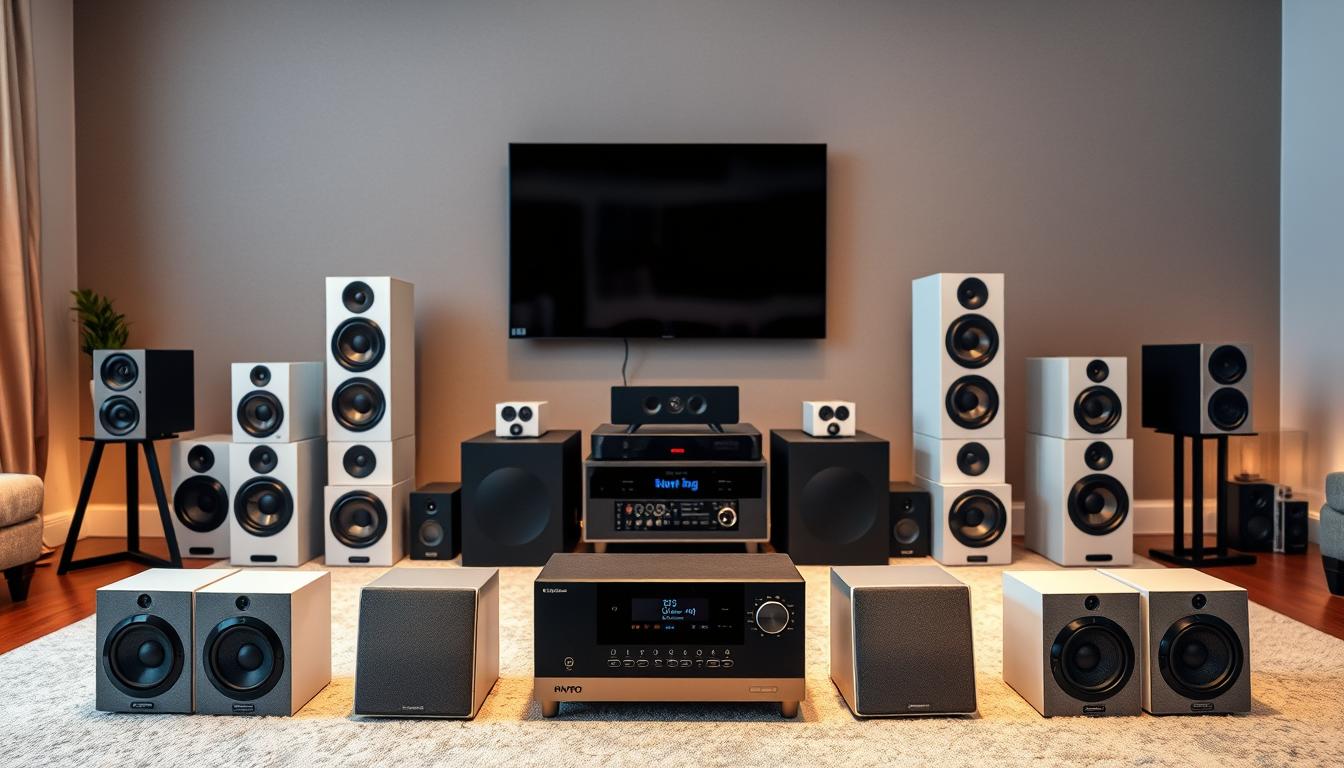Did you know 63% of homeowners with multi-room audio systems regret their initial speaker choices within the first year? They face uneven sound quality, dead zones, and frustration. These issues could have been avoided with better planning.
Creating a seamless listening experience across your home isn’t just about buying the most expensive gear. It’s about understanding how room size, acoustics, and usage patterns affect your ideal setup. For example, a kitchen’s clattering surfaces need different tech than a vaulted living room. Bedrooms require whisper-quiet nighttime modes.
This guide helps you choose the right speakers for each room. You’ll see how compact satellite speakers work better in tight spaces. And how voice-optimized models, like those in our best soundbars for voice quality roundup, ensure clear dialogue everywhere.
Key Takeaways
- Room dimensions directly impact speaker type effectiveness
- Moisture-resistant models excel in kitchens and bathrooms
- Wireless systems simplify installation but require bandwidth planning
- Voice control compatibility future-proofs your setup
- Budget allocation should prioritize high-traffic areas first
Understanding Multi-Room Audio Technology
Creating seamless sound throughout your home starts with understanding how modern wireless multi-room speakers operate. These systems let you stream music to multiple zones at once or play different tracks in each room. They balance technical precision with user-friendly controls, but how does it all connect?
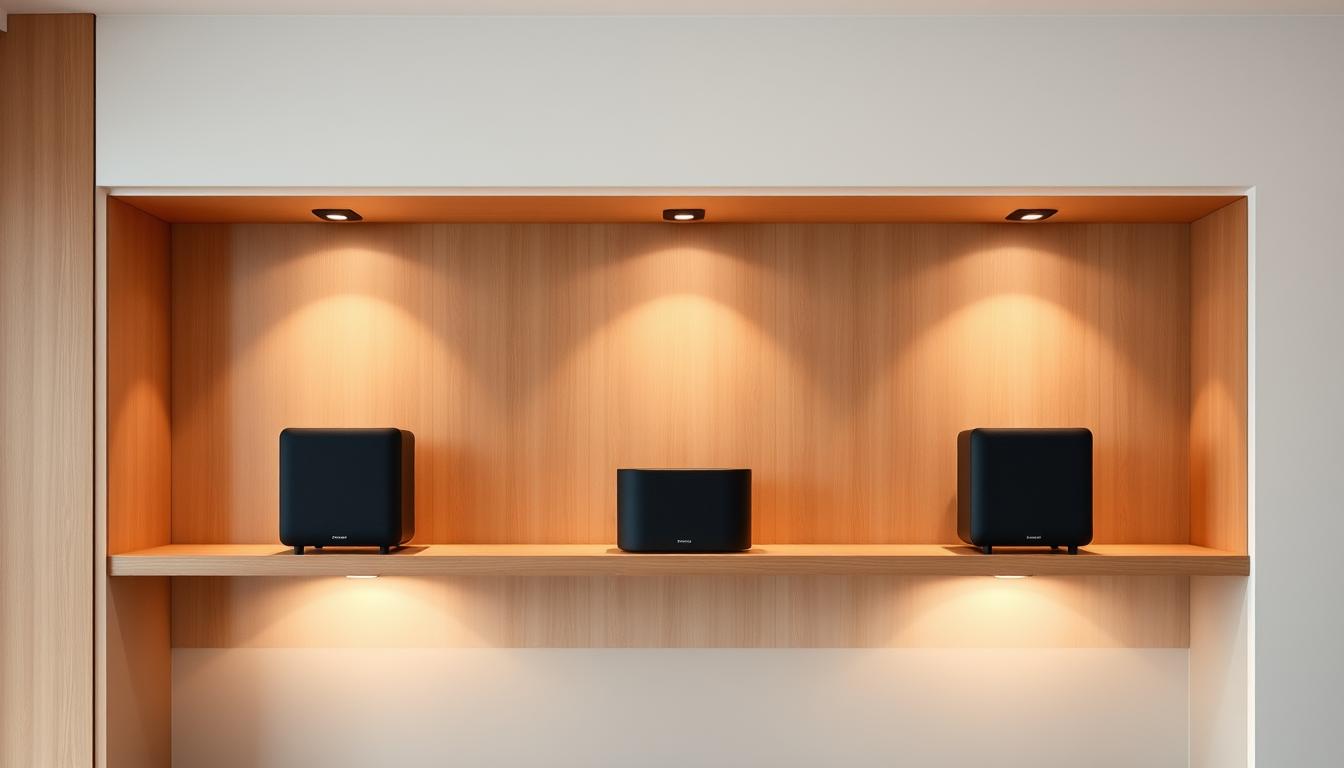
How Wireless Audio Distribution Works
Modern systems use WiFi and Bluetooth. WiFi-based systems, like Sonos, create a dedicated network for audio streaming. This allows:
- Higher quality lossless audio transmission
- Whole-home coverage without distance limitations
- Simultaneous streaming to 10+ rooms
Bluetooth speakers work well for single-room use but struggle with multi-zone synchronization. A 2023 study highlights:
“WiFi systems maintain latency under 50ms across entire homes, while Bluetooth delays exceed 200ms in multi-speaker configurations.”
Benefits of Synchronized vs Independent Zone Control
Your multi-room audio setup can either harmonize every speaker or let rooms operate independently. Bose’s ecosystem excels at synchronization, perfect for parties where timing matters. Independent control shines when family members want different music in separate areas.
| Feature | Synchronized Playback | Independent Zones |
|---|---|---|
| Audio Consistency | Perfectly timed across all rooms | Potential millisecond delays between zones |
| Control Flexibility | Whole-house commands only | Room-specific volume/track selection |
| Ideal Use Case | Entertaining guests | Multi-user households |
Matrix systems (wired alternatives) offer hybrid solutions but require professional installation. For most homes, wireless setups provide the best balance of convenience and performance. Just ensure your router can handle the audio data traffic – dual-band models work best for large properties.
Which Speakers Work Best for Multi-Room Systems: Core Considerations
When setting up a multi-room audio system, the tech specs are key. Your speaker picks affect how music moves between rooms and fits your life. Here are three main things to think about before buying your audio setup.
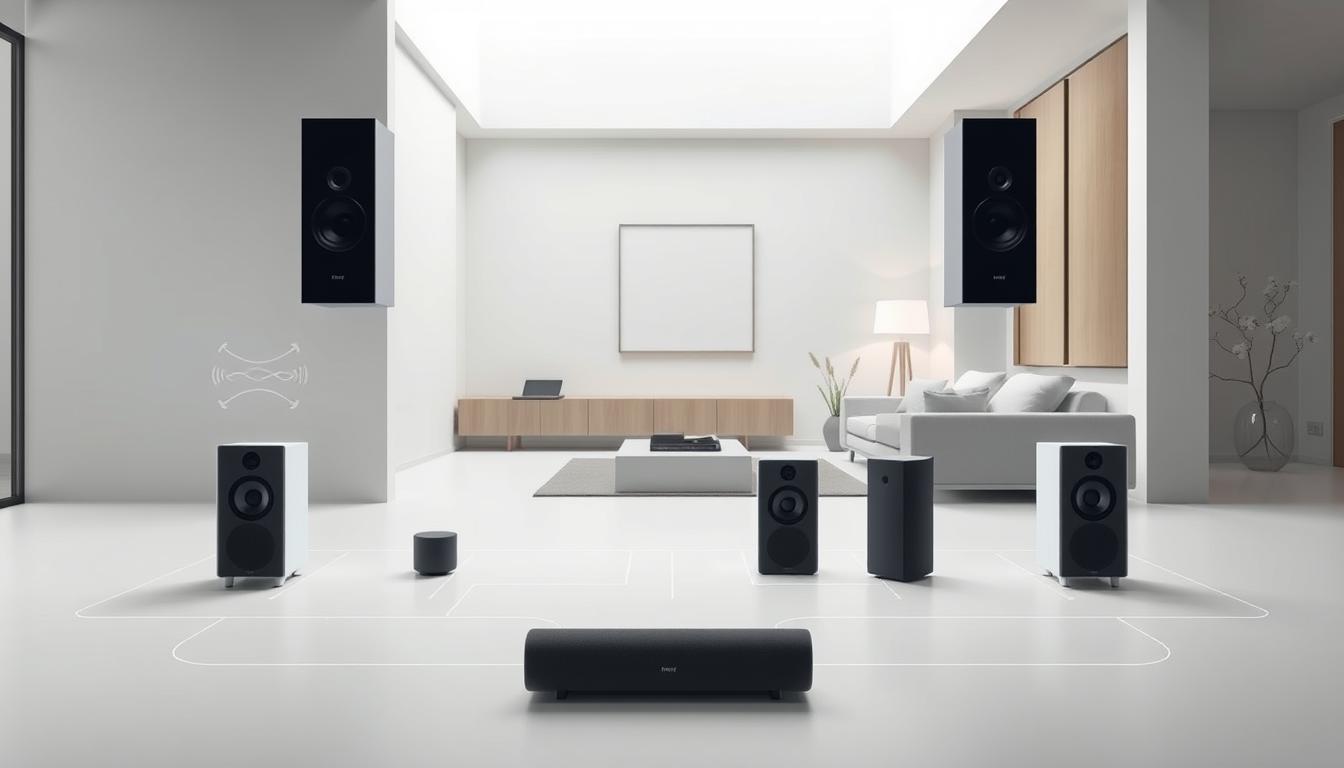
Wired vs Wireless Connectivity Requirements
Wired systems like Klipsch’s RP-600M bookshelf speakers give you clear sound but need a lot of setup work. They’re good for permanent setups during home remodels. On the other hand, wireless speakers like Sonos Five are easy to add to rooms using Wi-Fi or Bluetooth.
| Feature | Wired Speakers | Wireless Speakers |
|---|---|---|
| Installation | Requires professional setup | DIY-friendly |
| Sound Quality | Uncompressed audio | Depends on network strength |
| Scalability | Limited by wiring | Add speakers instantly |
Power Handling and Impedance Matching
Using the wrong speakers can hurt your amp or sound bad. Passive speakers need a receiver that can handle the power – check the Ohm ratings. Active wireless speakers like Sonos take care of the power, making setup easier. Here are some important specs to look at:
- Continuous power handling (RMS)
- Peak power capacity
- Impedance compatibility (4Ω vs 8Ω)
Voice Assistant Integration Needs
Voice control makes multi-room systems easy to use without touching anything. Bose Smart Speaker 500 works with Alexa and Google Assistant for commands like “Play jazz in the kitchen.”. Make sure your system works with your smart home devices. Some systems, like Sonos One SL, don’t have mics but can be controlled through an app, keeping your info private.
“Voice integration makes controlling whole-house audio easier – it’s more natural than using apps.”
Living Room Speaker Solutions
Your living room needs speakers that are both powerful and clear. The right speakers should fit your space and lifestyle well. Let’s look at two top-rated multi-room speakers for bigger rooms.

Sonos Five
Overview
Sonos Five offers high-fidelity stereo sound, making it feel like a theater. You can place it horizontally or vertically to adjust the sound.
Pros
Room-filling sound is its strong point, with a peak output of 110dB. It also adjusts the sound based on your room’s acoustics.
Cons
It needs 6.5” clearance for best performance. At $549, it’s a bit pricey compared to basic models.
Key Features
- Six custom drivers (three tweeters, three mid-woofers)
- Ethernet port for stable wired connections
- Works with 100+ streaming services
Bose Smart Speaker 500
Overview
This small unit gives 360° audio with Bose’s DSP technology. It fits well on shelves or console tables.
Pros
It has built-in Alexa/Google Assistant for voice commands. It also has dual-band WiFi and Bluetooth 4.2 for good connectivity.
Cons
It might not be the best for bass lovers. There’s no dedicated subwoofer output.
Key Features
- Eight-microphone array for precise voice recognition
- LCD display for album art and clock
- Spotify Connect and AirPlay 2 support
| Feature | Sonos Five | Bose Smart Speaker 500 |
|---|---|---|
| Sound Coverage | Up to 450 sq.ft. | Up to 300 sq.ft. |
| Voice Control | Requires external device | Built-in |
| Dimensions | 14.3 x 8.0 x 6.3” | 8.1 x 6.7 x 4.7” |
| Ideal For | Dedicated media rooms | Compact living spaces |
This multi-room speaker comparison highlights the difference in sound technology. Sonos focuses on directional sound, while Bose aims for all-around sound. Think about your room’s layout when picking between these top-rated multi-room speakers.
Kitchen Speaker Recommendations

Choosing speakers for your kitchen is all about finding the right balance. You need speakers that can handle moisture, fit well in tight spaces, and work with voice commands. Below, we look at two top wireless multi-room speakers that meet these needs.
Sonos One SL
Overview: Humidity-Resistant Compact Design
This 6.3″ speaker is perfect for kitchens. It’s IP65-rated, meaning it’s safe from moisture. Its matte finish also keeps fingerprints away, and the sealed electronics protect against steam damage.
Pros: Seamless Multi-Room Pairing, Voice Control
- Syncs instantly with 170+ Sonos products
- Works with Alexa/Google via connected devices
- Auto-switches between WiFi and Bluetooth
Cons: No Built-In Voice Assistant
It needs a smart display for voice commands. If you want voice control without extra devices, consider Amazon Echo models.
Key Features: Class-D Digital Amps, Anti-Distortion
Dual Class-D amplifiers give 110dB clarity. Custom waveguides ensure sound covers your kitchen well.
Denon Home 150
Overview: HEOS-Enabled Compact Powerhouse
This 7.1″ wide speaker supports high-quality audio. Its angled design helps sound reach over countertops.
Pros: High-Resolution Audio Support, AirPlay 2
- Plays lossless FLAC and ALAC files
- Dual-band WiFi minimizes dropouts
- Quick-switch between 3 preset music services
Cons: Bulky Design for Countertops
Its 4.3-lb weight makes it hard to move. Wall-mounting helps with space but requires a drill.
Key Features: 3.5″ Woofer + 1″ Tweeter
Dual drivers cover a wide range of frequencies. DSP tuning adjusts for background noise.
HEOS offers more audio formats, while Sonos is simpler for multi-room use. Check your counter space first. Denon’s model needs 10″ clearance, while Sonos is 6.3″ wide.
Bedroom Audio Options
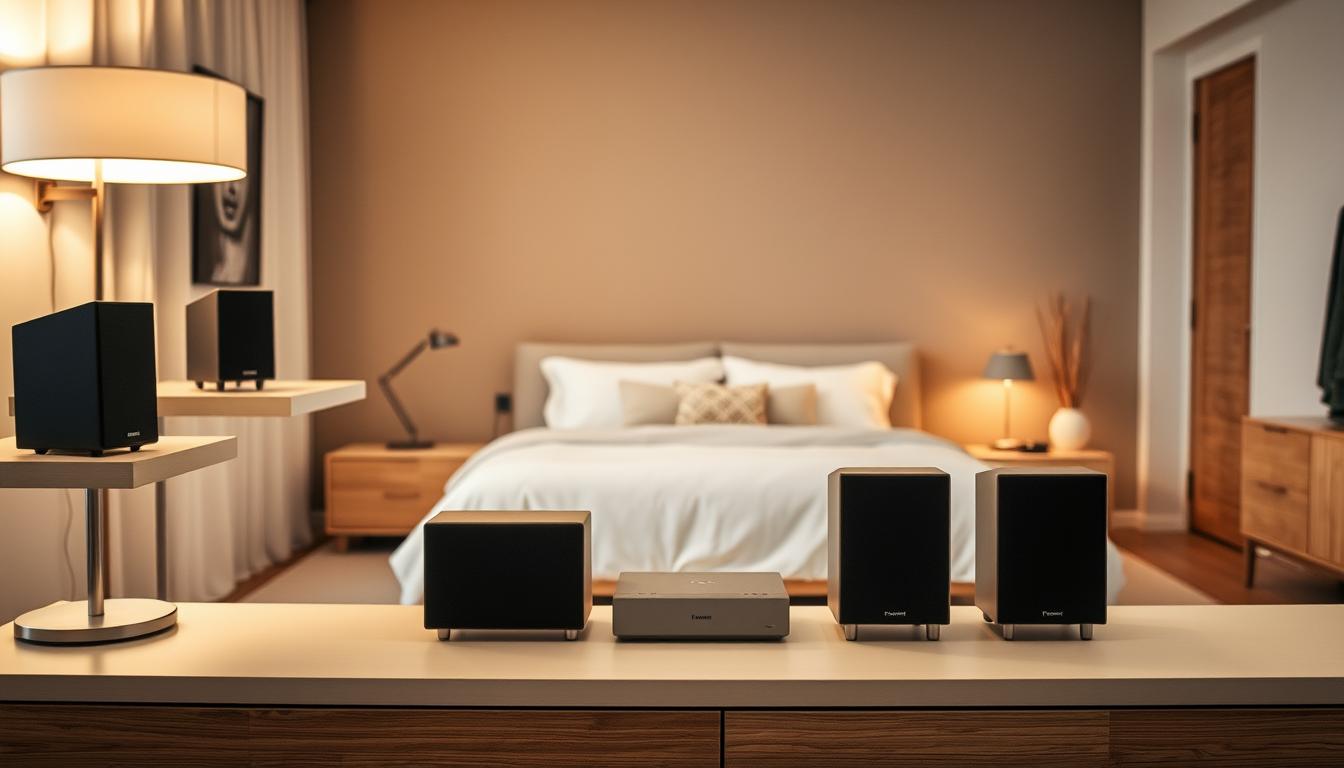
Your bedroom needs audio that’s both relaxing and useful. You might want soft wake-up sounds or calming sleep music. Modern smart speakers can give you just what you need. Let’s look at two great options for your bedroom.
Apple HomePod Mini
Overview: Spatial-Aware Smart Speaker
This small speaker uses ultra-wideband technology to adjust sound based on your room. It’s also made to handle humidity, perfect for rooms near bathrooms.
Pros
- Controls HomeKit devices like smart lights easily
- Has clear dialogue even at low volumes
Cons
- Needs Apple Music for full voice control
- Works best with Apple services
Key Features
- Has a sleep timer that fades music softly
- Allows you to talk to other rooms
Yamaha MusicCast 20
Overview: Bedside-Friendly Vertical Design
This tall speaker fits on narrow nightstands and sends sound up. It has a 2.5″ driver for clear audiobooks and podcasts.
Pros
- Has dual passive radiators for better bass
- Works with over 100 MusicCast devices
Cons
- Needs an external Alexa/Google Assistant
- No automatic sound adjustment
Key Features
- 20W power for loud sounds
- Has physical controls for quick changes
Both speakers keep voices clear even at low volumes, which is good for sleep. The HomePod Mini is great for smart home control. The MusicCast 20 lets you customize sound better.
Home Office Sound Systems
In today’s world, a good sound system is key for any home office. It’s important for video calls and relaxing with music. We’ll look at two top-rated multi-room speakers to improve your workspace.
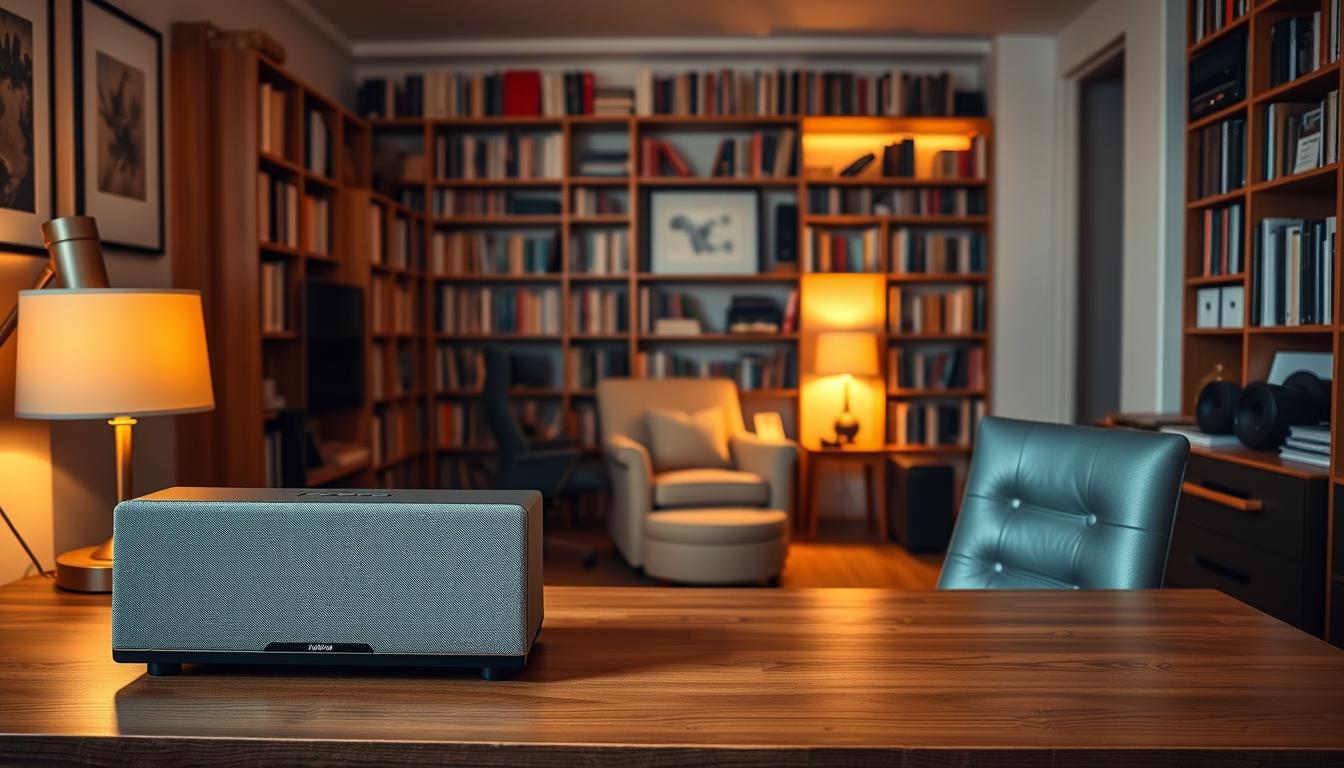
Amazon Echo Studio
Overview: 3D Audio for Video Conferencing
Amazon’s Echo Studio offers 360-degree sound for virtual meetings. Its design makes voices clear, perfect for team calls.
Pros
- Dolby Atmos support adds depth for movie nights
- It also controls smart home devices like lights and thermostats
Cons
- It needs a lot of desk space, which can be a problem
Key Features
- It has five speakers that adjust to your room
- Alexa helps with schedules and reminders
Bluesound Pulse Flex 2i
Overview: Hi-Res Audio Specialist
This speaker is for those who love high-quality sound. It uses Master Quality Authenticated (MQA) to keep music clear.
Pros
- It connects to 64+ zones for whole-home sound
- Its dual drivers offer clear sound at 80W power
Cons
- It’s more expensive than Amazon’s model
Key Features
- It has a Class D amplifier for clean sound
- Works with Alexa and Google Assistant for voice commands
Go for the Echo Studio if you value smart home features. Choose the Pulse Flex 2i for top-notch sound. Both speakers show that your office should sound as good as you do.
Bathroom-Friendly Speakers
Setting up audio in bathrooms needs special gear that works well in humid places. It must resist steam, protect against water, and be small. We’ll look at two great choices that are tough and sound good.

Polk Audio Atrium 4
Overview
This speaker is rated IPX4 and handles bathroom humidity easily. It’s also good for both inside and outside use. Its strong build is perfect for wet areas like showers or saunas.
Pros
Rust-proof aluminum grilles keep out moisture all year. The paintable casing fits any bathroom style. The Speed-Lock mounting system makes installation quick and easy.
Cons
This speaker needs a separate amplifier. If you want a multi-room system, you’ll have to buy more parts.
Key Features
A 4.5″ driver gives clear sound for podcasts or morning tunes. For bigger setups, pair it with Polk Audio’s home theater solutions for a unified sound system.
Bose Portable Smart Speaker
Overview
This water-resistant smart speaker is easy to move. It lets you play music anywhere, from countertops to outdoor tables.
Pros
Its 360° sound fills rooms well. The 12-hour battery means it lasts all day. Party Mode connects multiple speakers for a unified sound in different rooms.
Cons
It might not have enough bass for some. Its small size means it can’t produce deep sounds.
Key Features
Built-in Alexa and Google Assistant let you control it with your voice. It adjusts volume automatically to keep sound clear, even with water running.
When picking between Polk and Bose, think about what you need. Polk is great for permanent installations in steamy areas. Bose is perfect for those who like to move their speaker around. Both work well with popular wireless systems, making it easy to add more rooms to your audio setup.
Dining Room Audio Setup
Your dining area needs sound that matches meals and chats. It should offer background music without drowning out talks. The perfect setup should be clear for soft music and easy to control.
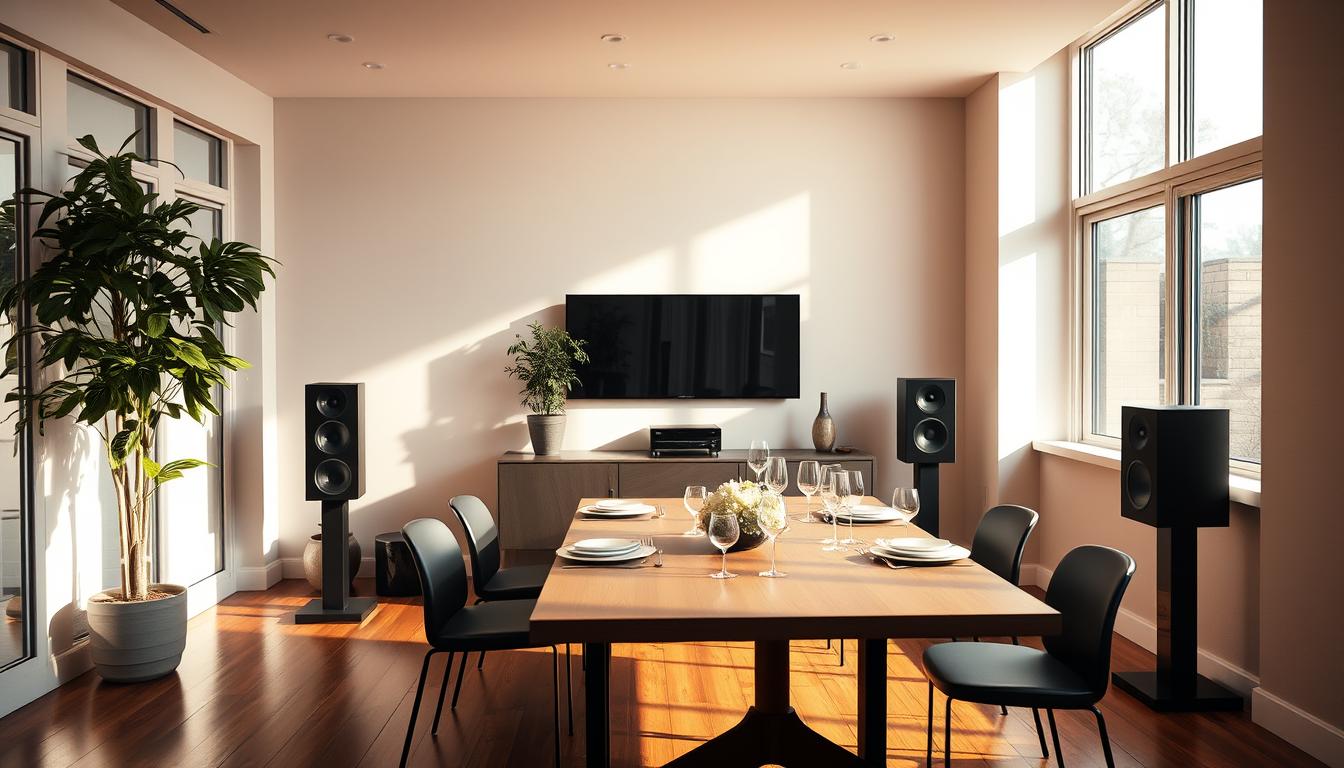
Sonos Beam
This small soundbar is great for dinner music. It has a dialogue enhancement mode for clear voices at low volumes. It uses four woofers and a tweeter for deep, rich sounds.
Pros
- HDMI ARC makes TV audio easy
- Voice control with Amazon Alexa
Cons
- Not perfect for big rooms
JBL Link Portable
This waterproof speaker is perfect for any dining room. It has Google Assistant for easy control. Its bass is deep for its size, and it’s safe from spills.
Pros
- 8-hour battery for moving around
- Small design fits anywhere
Cons
- Sound isn’t as wide as fixed speakers
| Feature | Sonos Beam | JBL Link Portable |
|---|---|---|
| Best For | Permanent installations | Flexible placement |
| Weather Resistance | None | IPX7 waterproof |
| Voice Assistant | Alexa | Google Assistant |
| Battery Life | N/A (Wired) | 8 hours |
For multi-room speaker comparison, Sonos Beam is for permanent setups. JBL is for those who need something portable. Both are top picks for best speakers for whole-house audio because they’re smart and sound great.
Outdoor/Patio Speakers
Outdoor speakers need to be tough and sound great. They must handle the weather and play clear sound in open spaces. Let’s look at two top picks that meet these needs.
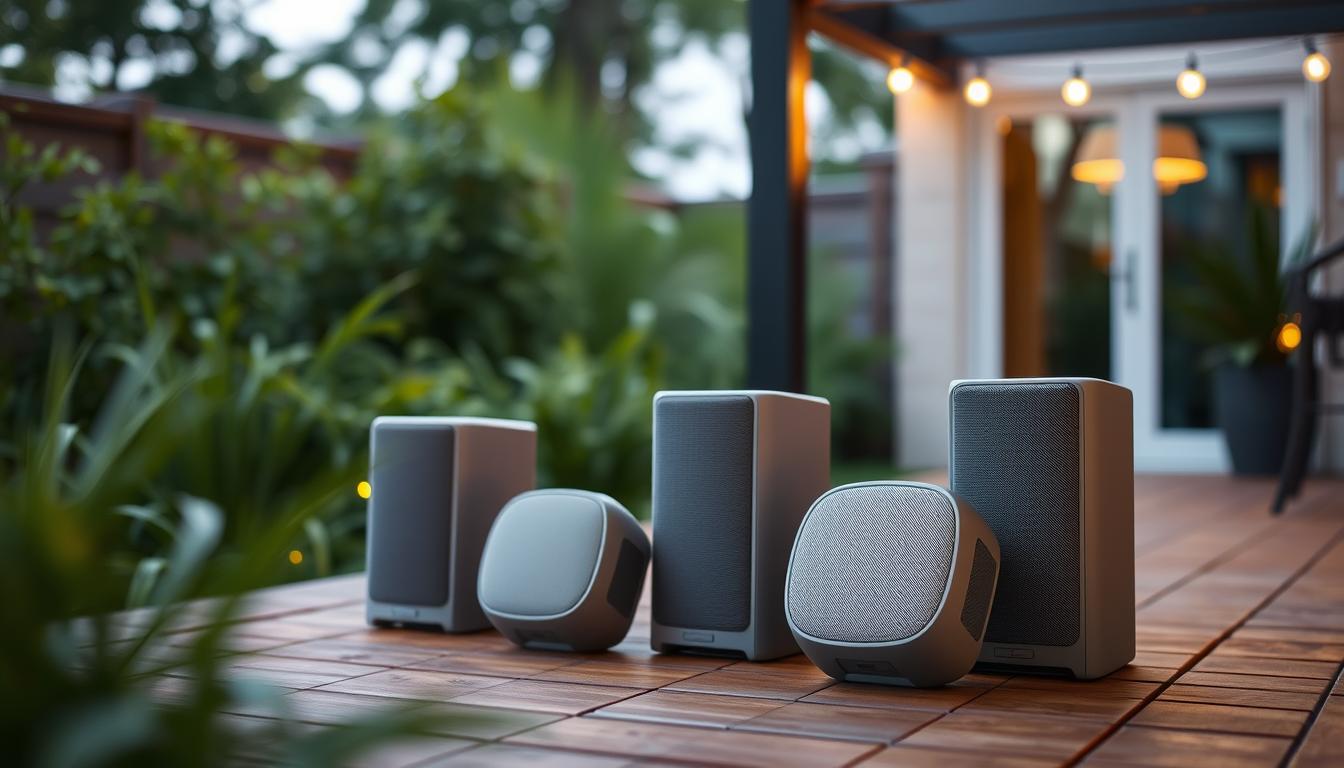
Sonos Move
Overview: Weather-Resistant Portable
The Sonos Move is perfect for outdoor parties. It’s built to last and has a handle for easy moving. It’s also safe from dust and water jets.
Pros
- Auto Trueplay tuning adapts sound to your environment
- 10-hour battery life supports all-day use
- Seamless integration with existing Sonos multi-room speaker systems
Cons
- Weighs 6.6lbs – heavier than most portable options
- Premium price compared to basic Bluetooth speakers
Key Features
- Dual Class-D amplifiers for rich bass
- WiFi and Bluetooth connectivity options
- Voice control via Amazon Alexa or Google Assistant
Ultimate Ears MEGABOOM 3
Overview: Party-Proof Cylindrical Design
This speaker is made for parties. It has 360° sound and can handle being dropped in the pool. Its fabric is easy to clean, and it fits in cup holders.
Pros
- 20-hour battery outperforms most competitors
- Deep bass response for outdoor environments
- Floatable construction for poolside safety
Cons
- Lacks built-in voice assistant support
- Limited smart home integration compared to WiFi speakers
Key Features
- One-Touch music control for playlist navigation
- PartyUp feature syncs 150+ speakers
- Wireless charging compatible (with add-on dock)
Weatherproofing tip: The MEGABOOM 3 is better for areas that get wet. Sonos Move is great for voice control in your outdoor setup.
Home Theater Speaker Systems
Creating cinematic soundscapes needs special equipment. It must balance power with precision. For multi-room setups, your speakers should deliver immersive surround effects. They must also work well with other zones. Let’s look at two top-rated multi-room speakers that stand out.
Sonos Arc
Overview: Dolby Atmos Soundbar
The Sonos Arc changes the game with its Dolby Atmos sound. Its curved design holds eight elliptical woofers and three tweeters. This setup projects sound vertically and horizontally for true 3D audio.
Pros: Eleven Class-D Digital Amplifiers
This soundbar has eleven amplified channels. It creates detailed separation between dialogue, music, and effects. Automatic Trueplay tuning adjusts the sound based on your room’s acoustics. This is key for open-concept spaces connected to other audio zones.
Cons: Requires Sonos Sub for Full Effect
While impressive alone, the Arc really comes alive with the Sonos Sub. This adds depth to explosions and musical scores. But, it also raises the total system cost.
Key Features: Eight Elliptical Woofers, Three Tweeters
Unique driver shapes minimize distortion at high volumes. This ensures clear audio for both quiet dramas and action blockbusters. Seamless integration with existing Sonos systems makes whole-home syncing easy.

Bose Smart Soundbar 900
Overview: PhaseGuide Technology
Bose’s flagship model uses PhaseGuide technology. It bounces sound off walls, creating a wider soundstage than its size suggests. This works well in medium-sized rooms, common in multi-room audio setups.
Pros: QuietPort Bass Design, ADAPTiQ
The QuietPort system eliminates rattling during intense bass scenes. ADAPTiQ calibration tailors output to your specific room dimensions. Voice pickup remains crisp even when other zones play music.
Cons: Limited HDMI Inputs
With only one HDMI eARC port, you’ll need external switchers for multiple 4K sources. This complicates setups where the theater shares components with gaming consoles or streaming boxes in adjacent rooms.
Key Features: Five Transducers, Built-In Alexa
Five high-efficiency transducers deliver dialogue clarity that cuts through background noise. This is key when syncing audio across kitchen and living areas. Built-in Alexa allows voice control without interrupting movie playback in other zones.
Both systems show how modern home theaters can be multi-room audio setup anchors. The Sonos excels in dedicated entertainment spaces. Bose offers greater flexibility for mixed-use areas. Think about your existing equipment and room layouts when choosing between these audio powerhouses.
Garage and Workshop Audio
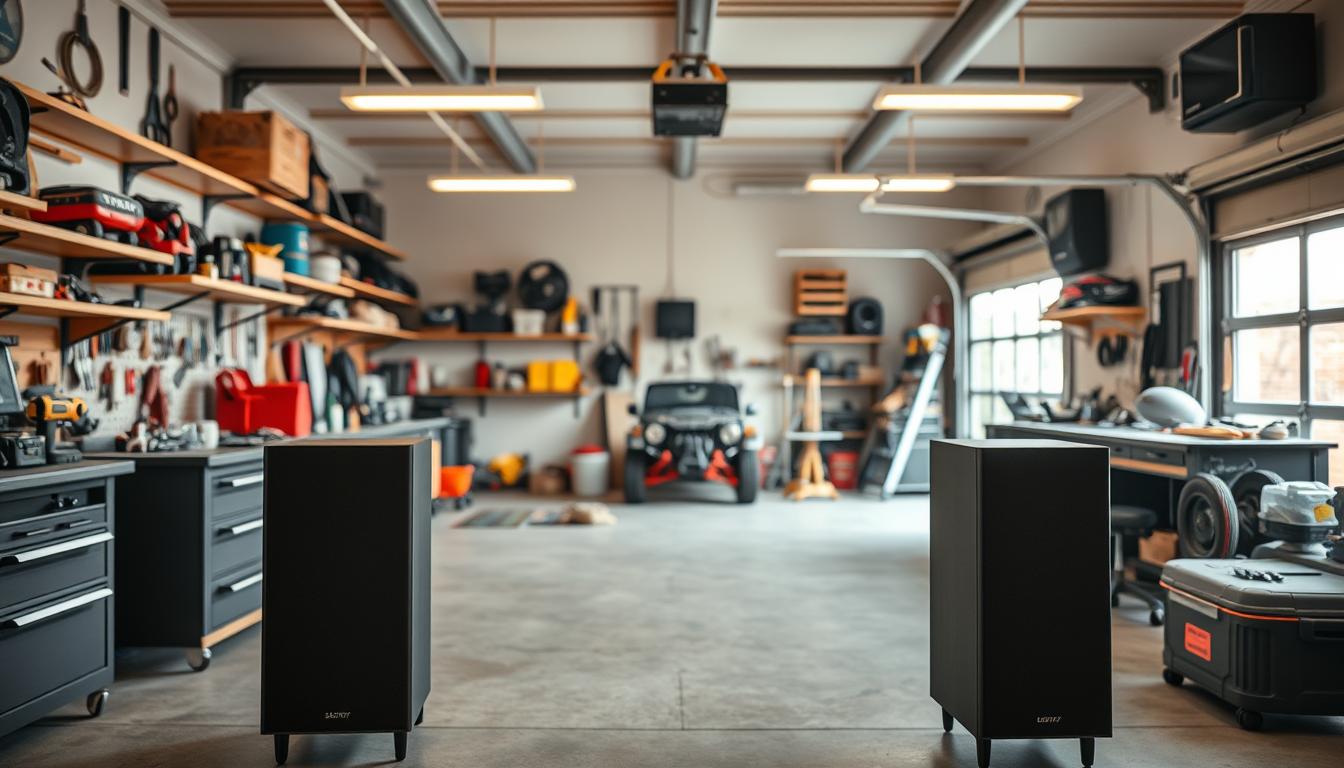
Your garage or workshop needs audio that can handle tough conditions. These areas face dust, vibrations, and sometimes moisture. They also have to cut through the noise of power tools. Let’s look at two wireless multi-room speakers made for these tough spots.
DeWalt DXCM601
Overview: Jobsite-Ready Bluetooth Speaker
This speaker is built for construction sites and works great in workshops. Its tough casing can handle drops, and it’s IP54 rated to keep out sawdust and water splashes.
Pros
- IP54 durability keeps out airborne particles and water spray
- 100dB max output cuts through drill and grinder noise
Cons
- Flat mids make music sound less clear
Key Features
- 20-hour runtime lasts through weekend projects
- USB port charges tools while music plays
JBL Boombox 2
Overview: Portable Party Speaker
This speaker is great for outdoor fun but also works well in garages needing strong bass. Its IPX7 rating means it can handle humid places better than most workshop speakers.
Pros
- 24-hour playtime lasts through long DIY projects
- Dual bass radiators boost low sounds
Cons
- 13lb weight makes it hard to move
Key Features
- Four drivers spread sound 360°
- Built-in handle makes carrying easier
Go with DeWalt for tool-compatible toughness in dusty areas, or JBL for strong bass in entertainment garages. Both work with multi-room speaker options, so you can play music everywhere.
Kids’ Room Speakers

Choosing speakers for kids means finding devices that are tough and safe. You want something that can handle sticky fingers and lets parents keep an eye on things. Two great options offer fun and safety, each in its own way.
Amazon Echo Dot Kids Edition
Overview: Parental Controls + Animal Designs
This smart speaker comes in tiger and panda designs. It has customizable volume limits to protect kids’ ears. Parents can use Alexa to approve music through an app.
Pros: FreeTime Unlimited Content
Subscribers get Audible books, Disney tracks, and educational podcasts for different ages. The 1.6″ front-firing speaker is great for stories, avoiding loud bass.
Cons: Limited Sound Quality
The speaker is okay for casual listening but not for complex music. It peaks at 80Hz, good for nursery rhymes but not for parties.
Key Features: Sleep Timer Functionality
- Auto-shutoff from 15 minutes to 2 hours
- Voice-activated lullaby playlists
- Homework mode blocks entertainment content
JBL Flip 6
Overview: Rugged Portable Bluetooth
This speaker is made for active kids. It can handle drops and water. The 44mm x 70mm racetrack driver makes sound that fills a room.
Pros: IP67 Rating + PartyBoost Pairing
It’s perfect for taking music anywhere with 12-hour battery life. It’s also dustproof. You can link multiple units for music everywhere.
Cons: No Voice Assistant
This Bluetooth-only model needs manual pairing. It lacks voice control but is simple for kids.
| Feature | Amazon Echo Dot Kids | JBL Flip 6 |
|---|---|---|
| Child-Safe Volume Limits | Yes | No |
| Water/Dust Resistance | None | IP67 Certified |
| Voice Commands | Alexa Integration | Not Supported |
| Battery Life | Plug-In Only | 12 Hours |
The Echo Dot is great for multi-room setups, while the Flip 6 is perfect for outdoors. Consider using both for a mix of safety and fun.
Hallway and Entryway Audio

Your hallway and entryway set the tone for your home. They’re perfect for discreet audio solutions. Compact speakers that blend with decor and deliver crisp sound work best here. Let’s explore two top options for these high-traffic areas.
Sonos Roam
Overview: Slim-profile portable
This pencil-shaped speaker fits into narrow shelves or wall mounts easily. Its auto-switch between WiFi/Bluetooth keeps music playing as you move from room to entryway.
Pros
- Survival-ready with IP67 dust/water resistance
- Convenient wireless charging via Qi pads
Cons
- 10-hour battery requires nightly charging
Key Features
- Trueplay tuning adapts to any space
- Multi-room pairing via Sonos app
Bose SoundLink Micro
Overview: Ultra-compact outdoor speaker
Smaller than a soda can, this rugged device hooks onto bags or brackets. The tear-resistant strap withstands daily bumps in busy hallways.
Pros
- Surprisingly deep bass from custom transducer
- Voice prompts for easy Bluetooth pairing
Cons
- 6-hour playtime limits all-day use
Key Features
- Built-in mic for voice commands
- Party Mode syncs multiple units
For wireless multi-room speakers, Sonos Roam excels in smart home integration. Bose SoundLink Micro offers grab-and-go durability. Choose based on whether you need seamless connectivity or physical portability.
Whole-House vs Room-Specific Setups
Deciding between a whole-house audio network and room-specific speakers depends on your lifestyle and budget. Whole-house systems fill every corner with sound. Room-specific setups focus on areas where music is most important. Let’s explore the options to help you choose.

Centralized Matrix Systems
Wired matrix systems are the heart of whole-house audio, providing clear sound through hidden speakers. They use a central amplifier and in-wall wiring, perfect for new homes or big renovations. Sonos and Bose offer wireless options that work like these without the need for invasive wiring.
Matrix systems offer unmatched sound quality but need a pro setup and cost more upfront. Adding more wireless speakers to Sonos makes adding zones easy. Bose’s designs let you start small and grow your system over time.
Hybrid Wireless Solutions
Hybrid systems mix wired and wireless tech for great sound. You might wire main areas and use portable speakers for others. This is good for homes with existing wiring but avoids wireless setup limits.
Key benefits include:
- Easier updates for tech-challenged rooms
- Lower latency for video sync in home theaters
- Compatibility with different brands (Sonos + third-party speakers)
Scalability Considerations
Future-proofing means planning for:
- The maximum number of zones your amplifier can handle
- The wireless network bandwidth you need (5GHz vs 2.4GHz)
- The cost per room – wired systems are about $300/zone, wireless $150
Sonos can handle up to 32 zones, and Bose Smart Soundbars work with existing systems. Always plan for 20% extra capacity for future growth.
Budget-Friendly Multi-Room Options
Creating a seamless audio experience across your home doesn’t require emptying your wallet. Affordable multi-room systems now deliver impressive sound and smart features. This lets you enjoy synchronized music in every room. Let’s explore three cost-effective ecosystems that balance performance and price.
Amazon Echo Ecosystem
The Amazon Echo lineup offers unmatched flexibility for budget-conscious users. Start with an Echo Dot in smaller spaces and add Echo Studio speakers for richer bass in larger rooms. Alexa voice control handles multi-room grouping effortlessly, and the system supports Spotify, Apple Music, and Amazon Music HD.
Though entry-level Echo devices use smaller drivers, their adaptive sound tech compensates well for casual listening. You can expand gradually—pair two Echo Dots for stereo sound or mix device types across floors. Monthly deals during Prime Day events make this ecosystem even more accessible.
Google Nest Audio Pairing
Google’s Nest Audio speakers shine in open-plan spaces with their 75mm mid-woofers and 19mm tweeters. Two Nest Audio units create a stereo pair that fills kitchens or living rooms with crisp vocals. The Google Home app simplifies zone creation, letting you group speakers across multiple floors.
Voice match technology personalizes music recommendations, while Chromecast built-in ensures compatibility with 3,000+ apps. Compared to Amazon’s system, Google prioritizes mid-range clarity over thunderous bass—ideal for podcasts and acoustic tracks.
IKEA Symfonisk Collaboration
IKEA’s partnership with Sonos produces the Symfonisk series—speakers disguised as bookshelf lamps or wall panels. These devices tap into Sonos’ robust multi-room platform at half the price of Play:1 speakers. The 3.5″ mid-woofer delivers surprisingly full sound for their compact size.
What makes Symfonisk unique? Physical design integration. The picture frame speaker blends into your decor while streaming lossless audio. You can later upgrade to higher-end Sonos components without replacing existing units—a smart path for gradual system expansion.
Conclusion
Choosing the right speakers for multi-room systems is key. The Sonos Five is great for living rooms with its rich sound. For kitchens, the Sonos One SL is a good choice.
Bedrooms do well with voice-controlled devices like the Apple HomePod Mini. For bathrooms, weatherproof models like the Polk Audio Atrium 4 are best.
For a consistent sound across your home, choose systems that grow with you. The Bose Smart Speaker 500 and Yamaha MusicCast 20 are good for this. If you’re on a budget, try IKEA Symfonisk with Amazon Echo devices.
Outdoor areas need speakers that can handle the weather. The Sonos Move or JBL Boombox 2 are good options.
Hybrid systems can offer the best of both worlds. Use wireless speakers like the Denon Home 150 with wired systems for the best sound. Make sure to check the speaker’s specs before mixing them.
Your setup should match how you use each room. Home offices need clear sound, like from the Bluesound Pulse Flex 2i. Kids’ rooms should have durable speakers, like the JBL Flip 6.
When looking at multi-room speaker reviews, compare sound quality and smart features. With the right setup, your home will have seamless audio in every room.
FAQ
What’s better for whole-house audio: WiFi or Bluetooth distribution?
WiFi systems like Sonos offer wider coverage and better sound quality. They also let you play music in multiple rooms at once without losing signal. Bose shows how WiFi is better for controlling everything from one place, unlike Bluetooth which is better for each room separately.
Do multi-room speakers require special wiring?
Wireless systems like Sonos don’t need complicated wiring. But, Klipsch wired setups need special cabling for clear sound. Source 1 explains how wireless systems are easier to set up but might need power outlets near each speaker.
How important is voice control in multi-room systems?
Voice control is very important, thanks to Amazon Alexa and Google Assistant. They let you control your speakers with just your voice. This is great for places like kitchens and bedrooms, as Source 1 shows.
Can outdoor speakers handle humidity and temperature changes?
Yes, Polk Audio Atrium 4 speakers can handle moisture and temperature changes. They have an IPX4 rating, making them better than indoor speakers. For outdoor use, choose weatherproof speakers over portable ones, like Polk’s over Bose’s.
What’s the best solution for low-volume nighttime listening?
For quiet listening at night, Apple HomePod Mini and Yamaha MusicCast 20 are good choices. They offer clear sound even at low volumes. Use a sleep timer, as Source 3 suggests, to turn them off when it’s time to sleep.
How do I ensure clear conference calls in home office setups?
For clear calls, use speakers like Amazon Echo Studio and Bluesound Pulse Flex 2i. Place them 2-3 feet from your desk, as Source 1 advises. This helps reduce echo and improves sound quality.
Which systems handle surround sound for home theaters?
Sonos Arc has 11 drivers for better surround sound than Bose Smart Soundbar 900. Use subwoofers, as Source 1 suggests, for deep bass in movies.
Are battery-powered speakers viable for workshops?
Yes, speakers like JBL Boombox 2 are great for mobile workspaces. But, DeWalt DXCM601 works with tools via Bluetooth. Source 1 says speakers should be loud enough to beat power tool noise.
How do I child-proof kids’ room speakers?
Use Amazon Echo Dot Kids Edition for volume limits and safe content. JBL Flip 6 is durable for kids. Source 2’s app can turn them off automatically at bedtime.
What’s the cost difference between wired and wireless systems?
Wireless systems like Sonos/Bose cost 0-0 per zone but are easy to add more. Denon HEOS matrix systems need an amplifier upfront. Source 3 says wireless systems are more flexible over time, even if they cost more per unit.
Can budget systems deliver quality whole-home audio?
Yes, IKEA Symfonisk bookshelf speakers are affordable and good for whole-home sound. Amazon Echo’s multi-room feature works well for basic needs. Source 2 says these options are better than wired setups under
FAQ
What’s better for whole-house audio: WiFi or Bluetooth distribution?
WiFi systems like Sonos offer wider coverage and better sound quality. They also let you play music in multiple rooms at once without losing signal. Bose shows how WiFi is better for controlling everything from one place, unlike Bluetooth which is better for each room separately.
Do multi-room speakers require special wiring?
Wireless systems like Sonos don’t need complicated wiring. But, Klipsch wired setups need special cabling for clear sound. Source 1 explains how wireless systems are easier to set up but might need power outlets near each speaker.
How important is voice control in multi-room systems?
Voice control is very important, thanks to Amazon Alexa and Google Assistant. They let you control your speakers with just your voice. This is great for places like kitchens and bedrooms, as Source 1 shows.
Can outdoor speakers handle humidity and temperature changes?
Yes, Polk Audio Atrium 4 speakers can handle moisture and temperature changes. They have an IPX4 rating, making them better than indoor speakers. For outdoor use, choose weatherproof speakers over portable ones, like Polk’s over Bose’s.
What’s the best solution for low-volume nighttime listening?
For quiet listening at night, Apple HomePod Mini and Yamaha MusicCast 20 are good choices. They offer clear sound even at low volumes. Use a sleep timer, as Source 3 suggests, to turn them off when it’s time to sleep.
How do I ensure clear conference calls in home office setups?
For clear calls, use speakers like Amazon Echo Studio and Bluesound Pulse Flex 2i. Place them 2-3 feet from your desk, as Source 1 advises. This helps reduce echo and improves sound quality.
Which systems handle surround sound for home theaters?
Sonos Arc has 11 drivers for better surround sound than Bose Smart Soundbar 900. Use subwoofers, as Source 1 suggests, for deep bass in movies.
Are battery-powered speakers viable for workshops?
Yes, speakers like JBL Boombox 2 are great for mobile workspaces. But, DeWalt DXCM601 works with tools via Bluetooth. Source 1 says speakers should be loud enough to beat power tool noise.
How do I child-proof kids’ room speakers?
Use Amazon Echo Dot Kids Edition for volume limits and safe content. JBL Flip 6 is durable for kids. Source 2’s app can turn them off automatically at bedtime.
What’s the cost difference between wired and wireless systems?
Wireless systems like Sonos/Bose cost $200-$900 per zone but are easy to add more. Denon HEOS matrix systems need an amplifier upfront. Source 3 says wireless systems are more flexible over time, even if they cost more per unit.
Can budget systems deliver quality whole-home audio?
Yes, IKEA Symfonisk bookshelf speakers are affordable and good for whole-home sound. Amazon Echo’s multi-room feature works well for basic needs. Source 2 says these options are better than wired setups under $1,000.
How do I optimize speakers for open-concept dining areas?
Use Sonos Beam for clear dialogue, and JBL Link Portable for 360° sound. Place speakers at ear level, as Source 1 advises, for even sound.
What makes a speaker suitable for bathrooms?
Look for speakers like Polk Atrium 4 with IPX4 rating for moisture resistance. Avoid speakers that need external amps. Source 1 says wireless speakers like Bose Portable Smart Speaker are better in humid places.
How do hybrid systems balance whole-house and room-specific needs?
Sonos systems switch between whole-home and single-room modes. Bose SoundLink Micro is good for specific rooms. Source 2 suggests using WiFi for main areas and Bluetooth for portable speakers.
What technical specs matter most for entry-level systems?
Look for systems with 50Hz-20kHz frequency response and 8-ohm impedance. Google Nest Audio has a good mid-woofer for bass. IKEA Symfonisk is easy to integrate with Sonos.
,000.
How do I optimize speakers for open-concept dining areas?
Use Sonos Beam for clear dialogue, and JBL Link Portable for 360° sound. Place speakers at ear level, as Source 1 advises, for even sound.
What makes a speaker suitable for bathrooms?
Look for speakers like Polk Atrium 4 with IPX4 rating for moisture resistance. Avoid speakers that need external amps. Source 1 says wireless speakers like Bose Portable Smart Speaker are better in humid places.
How do hybrid systems balance whole-house and room-specific needs?
Sonos systems switch between whole-home and single-room modes. Bose SoundLink Micro is good for specific rooms. Source 2 suggests using WiFi for main areas and Bluetooth for portable speakers.
What technical specs matter most for entry-level systems?
Look for systems with 50Hz-20kHz frequency response and 8-ohm impedance. Google Nest Audio has a good mid-woofer for bass. IKEA Symfonisk is easy to integrate with Sonos.
